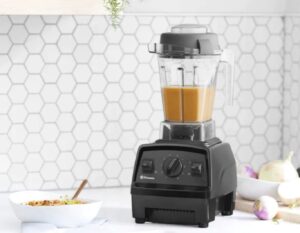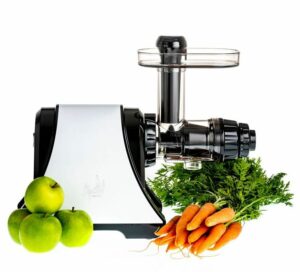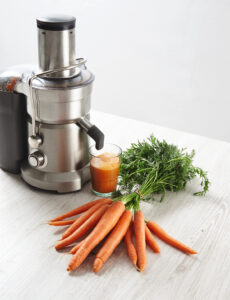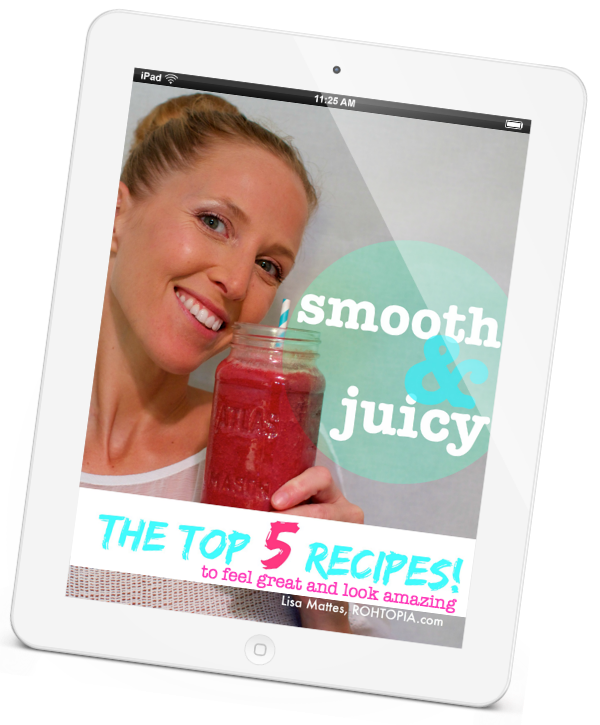When it comes to the question of juicing vs blending, there are two parties – some are strictly for fresh juices and call smoothies fads, others love nothing more than a creamy smoothie and think little of juicing.
For many, the only difference between smoothies and juices is that a smoothie is creamy and a juice is a thin liquid, but whether there are any advantages or disadvantages in juices or smoothies often seems to be unclear.
Both fresh juices and smoothies have their place in good and varied nutrition, and are each full of benefits.
Smoothies provide fiber, which slows the release of sugar into the blood, thus smoothies give your longer lasting, continuous energy. In addition smoothies can offer protein and “good” fat – eg avocado, they keep you full for a long time and, depending on ingredients, can even serve as a tasty dessert.
Juices, however, provide quick energy and are easily digestible because they are free of fiber. This is great for athletes but also for people with digestive problems, irritable bowel syndrome (IBS), Crohn’s or during a juice feast.
Find more recipes for smoothies and juices here and here.
What exactly happens when juicing vs blending?
 BLENDING
BLENDING
When you make a smoothie, you fill your blender with all kinds of fresh or frozen fruit, leafy greens and liquid – water, coconut water, juice or nut milk. You can also spice up your smoothie with cacao, mesquite, cinnamon, moringa and other superfoods and spices and turn your smoothie into something really special.
With a smoothie, you enjoy your ingredients completely, with skin and all nutrients, and the contained fibers activate your digestion, help to keep your blood sugar stable and can even assist in preventing certain cancers.
JUICING
Juicing can be done in 2 ways:
 1. Slow Juicers – masticating juicers (photo: white juicer). These juicers are said to be better since they treat the ingredients more gently and do not heat up which could result in nutrient loss. Slow juicers literally squeeze the juice out of your fruit and vegetables, and insoluble fiber is what’ s left.
1. Slow Juicers – masticating juicers (photo: white juicer). These juicers are said to be better since they treat the ingredients more gently and do not heat up which could result in nutrient loss. Slow juicers literally squeeze the juice out of your fruit and vegetables, and insoluble fiber is what’ s left.
Another advantage of slow juicers is that you can also make nut butters and ice cream with them.
Disadvantage – price, and more time consuming while juicing.
 2. Centrifugal juicers. These juicers shred your ingredients and centrifuge them to separate juice from fiber.
2. Centrifugal juicers. These juicers shred your ingredients and centrifuge them to separate juice from fiber.
Advantage: cheaper, faster to use.
Disadvantage: can heat up a bit which destroys nutrients. Also less effective when juicing leafy greens and herbs.
So juicing separates insoluble fiber from the rest. This makes it easier for your body to absorb micro nutrients and phyto nutrients, and gives it a direct nutrient and energy boost.
Juicing can be especially beneficial if you want to give your body a real vitamin boost, e.g. when you are sick. In those times, you do not want to activate or stress your digestive system too much, so your body can fully concentrate on healing. The Gerson Therapy uses exclusively fresh juices (www.gerson.org). And the amount of vegetables, leafy greens and fruit that you can take in by juicing is much larger than if you ate all of it as whole pieces.
2 EXAMPLES FOR JUICE RECIPES
1 big cucumber
8 stalks of celery
1 apple
5 leaves of kale
1/2 bunch parsley
2cm ginger
OR:
8 carrots
1 head of lettuce
8 stalks of celery
1/2 bunch kale
Quite a lot, isn’t it? If you tried to eat all of that, you would be busy for a while. Drinking just the juice on the other hand would be done within minutes. If it were a smoothie, blended with 1/2-1 Cup of water, it would already take you a bit longer to finish it.
Hence juices and smoothies are no pure thirst quenchers, but meals, and should be enjoyed sip by sip, slowly, instead of being gulped down in one big slurp. If you struggle with that, you can use a spoon to eat your smoothie or juice.
Yeah but without any fiber, a juice cannot be good for my blood sugar!
If you drink pure fruit juices, this is truly a valuable point – used at the right time in a cycling race, a sugar kick can be something great, but for the rst of the time, steady and balanced energy is preferable. You can easily achieve this by rather drinking vegetable juices and green juices (like the two recipes above), and by drinking them slowly. Apples, carrots, beets, pears or grapes should be used to sweeten your juice, while celery, cucumbers, other vegetables or even lemons should be the major part of your recipe
If you have diabetes or unbalanced blood sugar, it is better to get started with smoothies before juicing lots and lots, and it may also be a good idea to consult your doctor or naturopathic practitioner.
Blender or Juicer – what should I buy first?
If it is a question of money whether to get a juicer or a blender first, I would recommend a blender. It is more versatile, can not only make smoothies but also cookie dough, dips and salsas, and grind nuts or chop veggies and fruit. You can even make juice with your blender.
Click here to find out what kind of blender is best for you and here for a comparison of blenders.
If you often struggle with time, a blender is probably again a better idea since it is incredibly easy to clean. You only need to rinse the container. With juicers, there are some models that you have to take apart completely – though your speed will depend on your practise and habit. If yo daily make juice, it will take you half the time after just a week, and you will have even cleaned everything.
If you simply have the choice what to get, simply go with what you like better and know that you are doing yourself good either way. Some people like to juice, some just love their blender.
YOUR OPINION:
Did you first get a juicer or a blender?
And what is YOUR favourite recipe, no matter whether smoothie or a juice?





